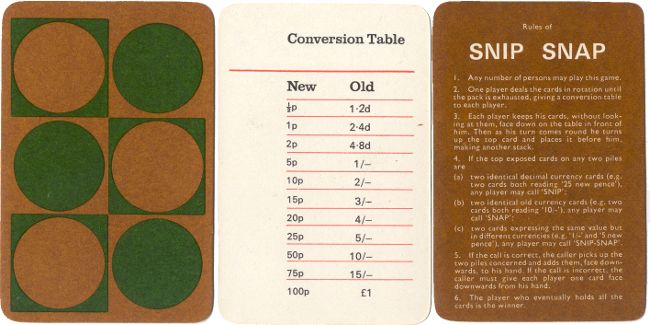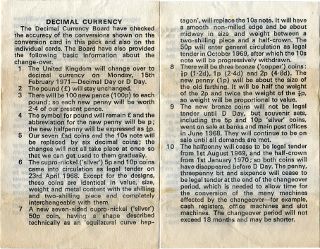Snip Snap
Decimal Snap created by Eric Wagstaff, published by Michael Stanfield Holdings, London 1968.
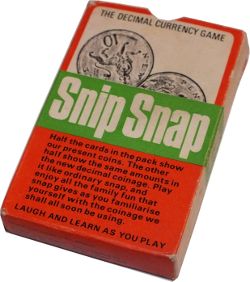
Decimal Snap created by Eric Wagstaff, published by Michael Stanfield Holdings in 1968
Michael Stanfield was a publisher of children's books (Rupert Bear, etc.) and games (jig-saw puzzles, Nine Men's Morris, Bridge sets, etc.) in the late 1960s, 70s and early 80s. ‘Snip Snap’, the Decimal Currency game, was played like Snap and aimed to familiarize players with the new decimal coinage and monetary values. Half of the pack shows sums of money in old English currency whilst the other half shows the same amounts in new (decimal) currency. Players call “snap” when cards showing the same amount are played. The rules are briefly described on the box and on the back of the Conversion Tables, whilst a leaflet enclosed with the cards explains the schedule of events during the changeover to decimal currency (click images to zoom) →
See also: Change for a Shilling►
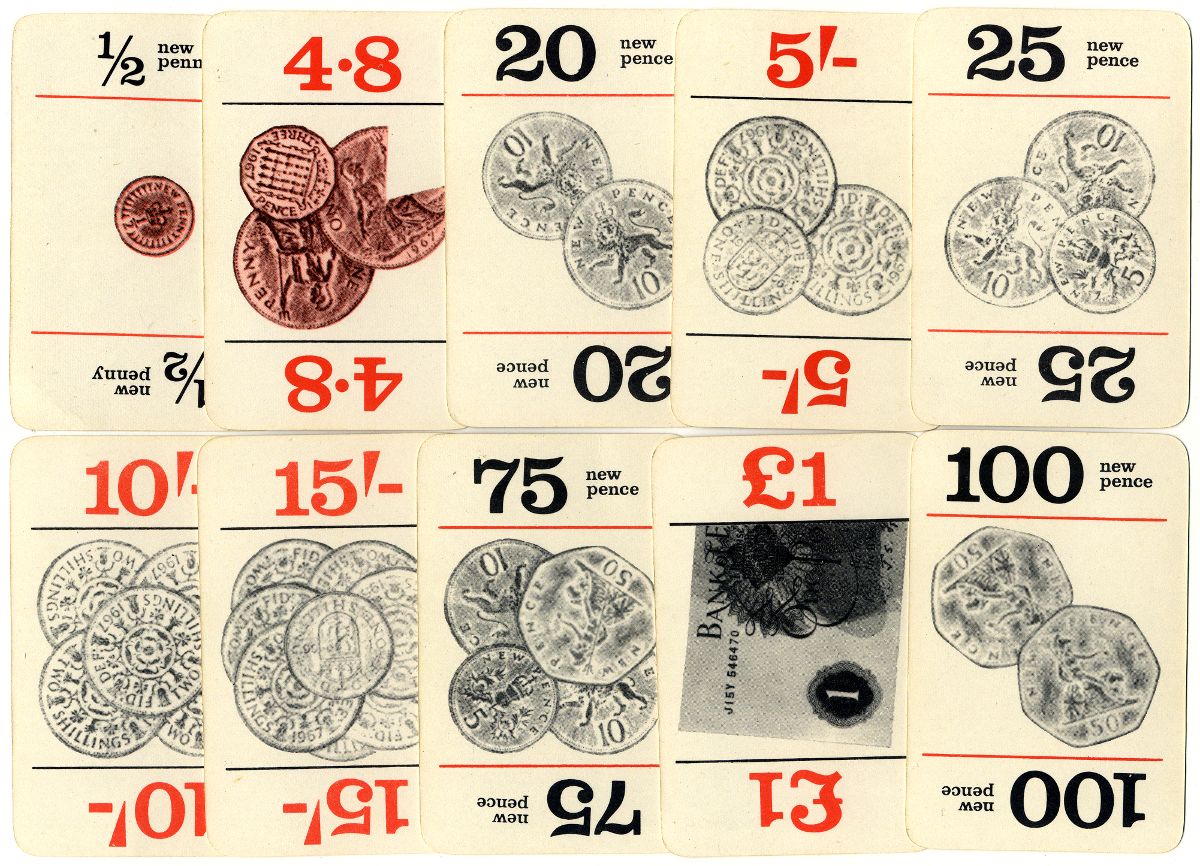
Above: Decimal Snap created by Eric Wagstaff, published by Michael Stanfield Holdings, London 1968. . A total of 48 cards: 24 cards arranged in 12 sets of 2 to show `old money' 1.2d, 2.4d, 4.8d, 1/-, 2/-, 2/6d, 3/-, 4/-, 5/-, 10/-, 15/-, £1; 24 cards arranged in 12 sets of 2 to show `new money', ½p, 1p, 2p, 5p, 10p, 12½p, 15p, 20p, 25p, 50p, 75p, 100p. Additional cards showing conversion table between old and new money.
Note: The abbreviation for the old penny, d, was derived from the Roman ‘denarius’, and the abbreviation for the shilling, s, from the Roman ‘solidus’. The shilling was also denoted by the slash symbol / , also called a solidus for this reason and used today in website addresses, which was originally an adaptation of the long s.
Below Left: the back design, a Decimal Currency Conversion Table and rules. The rules were also provided on folded card, printed on both sides: one side green, one side the rules. Right: leaflet enclosed with the cards explaining the schedule of events during the changeover to decimal currency (click images to zoom) →
By Simon Wintle
Spain • Member since February 01, 1996 • Contact
I am the founder of The World of Playing Cards (est. 1996), a website dedicated to the history, artistry and cultural significance of playing cards and tarot. Over the years I have researched various areas of the subject, acquired and traded collections and contributed as a committee member of the IPCS and graphics editor of The Playing-Card journal. Having lived in Chile, England, Wales, and now Spain, these experiences have shaped my work and passion for playing cards. Amongst my achievements is producing a limited-edition replica of a 17th-century English pack using woodblocks and stencils—a labour of love. Today, the World of Playing Cards is a global collaborative project, with my son Adam serving as the technical driving force behind its development. His innovative efforts have helped shape the site into the thriving hub it is today. You are warmly invited to become a contributor and share your enthusiasm.

Related Articles

Lend Me Five Shillings
or “Her Majesty’s Privy Purse” - a merry round-the-table game published by D. Ogilvy.
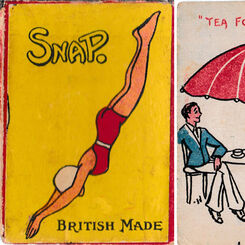
Snap
Anonymous Snap game, 1930s.

C.W.F Snap
C.W.F Snap, c.1902.
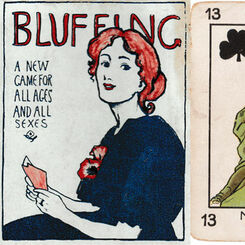
Bluffing
Bluffing published by C.W. Faulkner & Co, c.1896.
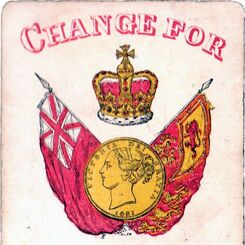
Change for a Sovereign
Change for a Sovereign published by J Evans & Sons and printed by Kronheim & Co.
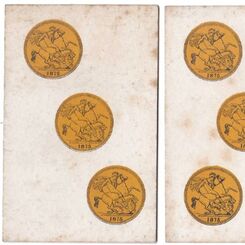
Shearing the Sheep
Shearing the Sheep published by J. Jaques & Son, c.1875.

Victory Snap
Wartime Snap, a memoir of past times, c.1941.
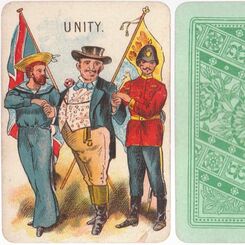
Oppenheimer und Sulzbacher
Card games produced in Germany by Oppenheimer und Sulzbacher.
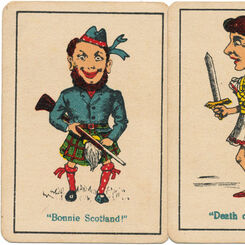
Snap
Spear’s “Snap” card game from the 1920s.
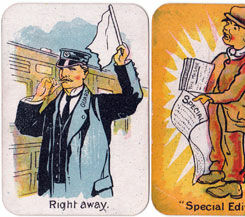
Special Edition Snap 1912
Chad Valley Special Edition ‘Snap’ card game, 1912.
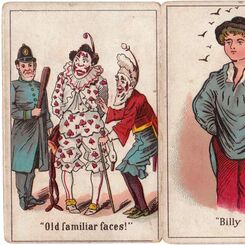
Anonymous Snap game
Anonymous “Snap” game from the late 19th century.
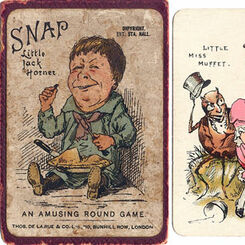
Jack Horner Snap
“Little Jack Horner” Snap made by Thomas De la Rue & Co Ltd, c.1890.
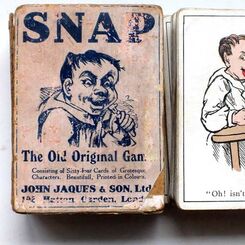
Snap
Snap, the Old Original Game, has captured the imaginations of children for over a century!
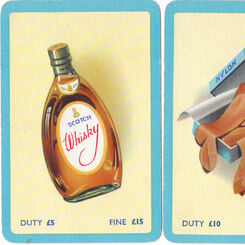
Contraband
Contraband by Pepys Games was first published in early 1950s.
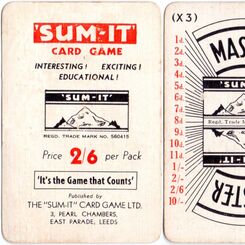
Sum-it Card Game
‘Sum-it’ Card Game published by Sum-It Card Games Ltd. c.1935.
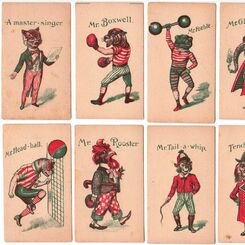
Animal Snap
The full set of this 'Snap' card game is believed to have 9 characters in sets of four, making a tot...
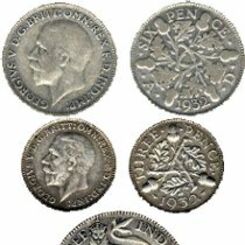
Change for a Shilling
Change for a Shilling card game by Geo. Wright & Co., London, c.1910-1926.

Kay Snap
Kay Snap Children's Card Game, made in England, 1930s.
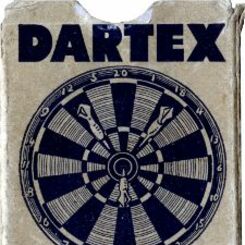
Dartex
Dartex, the Thrilling New Card Game of Skill (1938) based on the traditional pub game where darts ar...
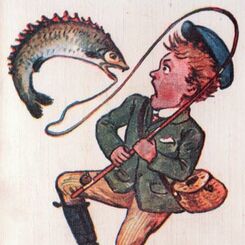
Snap
An anonymous Snap game purporting to be “British Make”, 1930s.
Most Popular
Our top articles from the past 60 days


